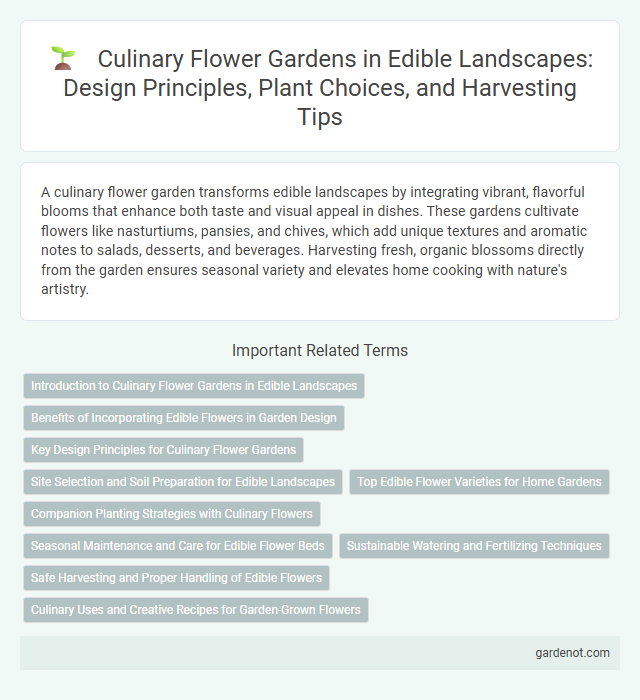A culinary flower garden transforms edible landscapes by integrating vibrant, flavorful blooms that enhance both taste and visual appeal in dishes. These gardens cultivate flowers like nasturtiums, pansies, and chives, which add unique textures and aromatic notes to salads, desserts, and beverages. Harvesting fresh, organic blossoms directly from the garden ensures seasonal variety and elevates home cooking with nature's artistry.
Introduction to Culinary Flower Gardens in Edible Landscapes
Culinary flower gardens integrate vibrant, edible blooms such as nasturtiums, calendula, and violets to enhance both flavor and aesthetics in edible landscapes. These gardens emphasize the cultivation of flowers that offer unique tastes and nutritional benefits, enriching dishes with natural color and texture. Incorporating culinary flowers supports sustainable gardening practices while expanding the diversity of food sources within residential or commercial edible landscapes.
Benefits of Incorporating Edible Flowers in Garden Design
Incorporating edible flowers in a culinary flower garden enhances biodiversity and attracts beneficial pollinators, improving overall garden health. These vibrant blooms provide fresh, flavorful ingredients that elevate culinary creations while offering visual appeal and seasonal variety. Utilizing edible flowers supports sustainable gardening practices by reducing food miles and promoting organic growth.
Key Design Principles for Culinary Flower Gardens
A successful culinary flower garden integrates edible blooms such as nasturtiums, pansies, and calendulas to enhance both flavor and visual appeal. Emphasize companion planting by arranging flowers near herbs and vegetables to attract pollinators and deter pests naturally. Prioritize soil health, sun exposure, and continuous bloom cycles to ensure a sustainable and productive edible landscape.
Site Selection and Soil Preparation for Edible Landscapes
Selecting a site with full sun exposure and well-drained soil is essential for a successful culinary flower garden within an edible landscape. Soil should be tested for pH balance, ideally between 6.0 and 7.0, and enriched with organic compost to enhance fertility and moisture retention. Proper soil preparation, including tilling and removing debris, ensures optimal root development and nutrient uptake for edible flowers like nasturtiums, calendulas, and violets.
Top Edible Flower Varieties for Home Gardens
The top edible flower varieties for home culinary flower gardens include nasturtiums, pansies, and calendulas, prized for their vibrant colors and peppery or citrusy flavors. Violas and borage offer delicate petals that enhance salads and desserts with a mild, cucumber-like taste, while chive blossoms bring a subtle onion flavor crucial for savory dishes. Incorporating these flowers not only elevates the visual appeal of dishes but also enriches nutritional value through antioxidants and vitamins.
Companion Planting Strategies with Culinary Flowers
Companion planting strategies in a culinary flower garden enhance both flavor and pest control by pairing edible blooms like nasturtiums, calendula, and borage with vegetables and herbs. Nasturtiums repel aphids from tomatoes, while calendula attracts pollinators that boost fruit set and borage deters cabbage pests, creating a synergistic ecosystem. Integrating these culinary flowers strengthens plant health, improves harvest quality, and adds vibrant visual appeal to edible landscapes.
Seasonal Maintenance and Care for Edible Flower Beds
Seasonal maintenance of a culinary flower garden requires regular pruning, soil enrichment, and pest management to ensure vibrant, healthy blooms ideal for consumption. Applying organic fertilizers and mulching during spring supports nutrient-rich soil, while consistent watering prevents stress in edible flower beds throughout dry periods. Monitoring for pests like aphids and using natural deterrents maintains plant health and maximizes the harvest of edible blooms across all seasons.
Sustainable Watering and Fertilizing Techniques
Sustainable watering and fertilizing techniques in a culinary flower garden emphasize efficient water use, such as drip irrigation and rainwater harvesting, to minimize waste and support plant health. Organic fertilizers like compost and worm castings enrich the soil without harmful chemicals, promoting robust growth of edible flowers. Incorporating mulch reduces soil evaporation and nutrient runoff, creating an eco-friendly environment that enhances both flavor and yield.
Safe Harvesting and Proper Handling of Edible Flowers
Safe harvesting of edible flowers requires selecting blooms at their peak freshness, preferably in the early morning when flavors are most concentrated and pesticide residues are minimal. Proper handling involves gently washing flowers in cool water to remove dirt and insects, followed by drying them carefully on paper towels to prevent bruising and moisture-related spoilage. Storing edible flowers in a single layer within an airtight container in the refrigerator maintains their texture and flavor until use in culinary dishes.
Culinary Uses and Creative Recipes for Garden-Grown Flowers
Culinary flower gardens offer a vibrant palette of edible blooms such as nasturtiums, pansies, and violets, prized for their unique flavors and visual appeal in dishes. Incorporating garden-grown flowers into salads, desserts, and infused beverages enhances both taste and presentation, providing fresh, organic ingredients rich in antioxidants. Creative recipes like lavender-infused honey, rose petal ice cream, and marigold pesto highlight the versatility and nutritional benefits of edible flowers harvested directly from the garden.
Culinary flower garden Infographic

 gardenot.com
gardenot.com